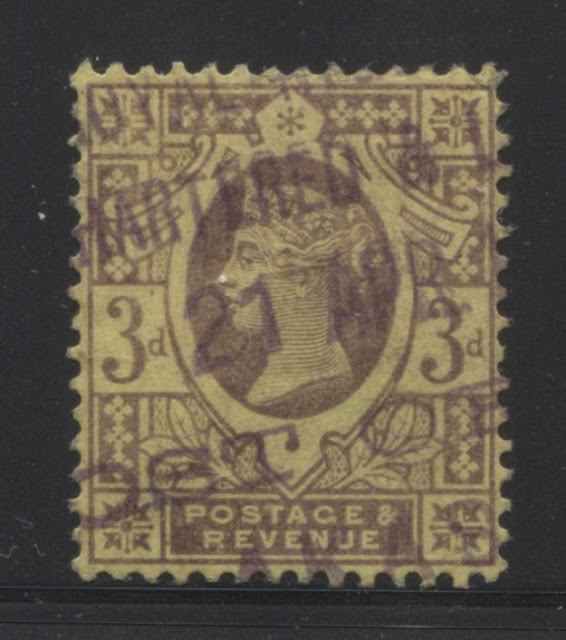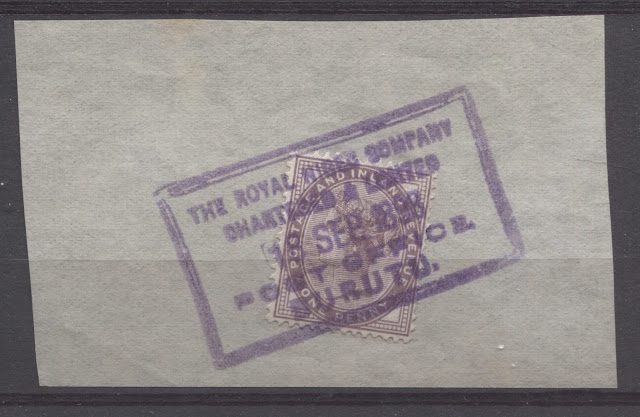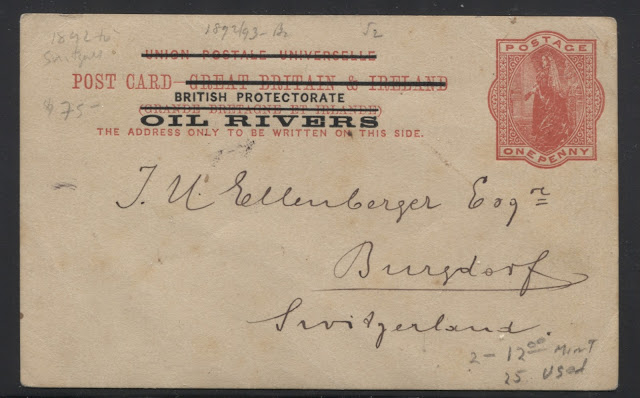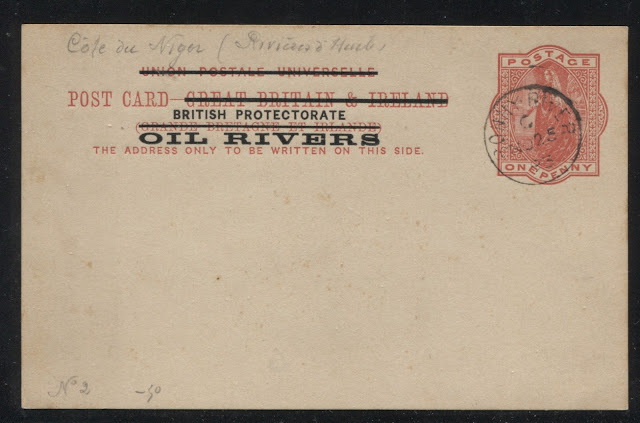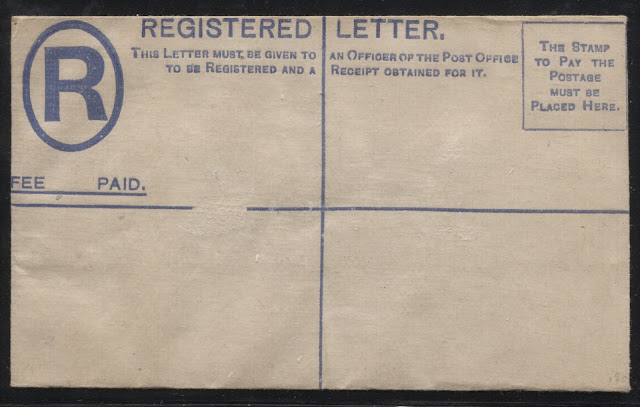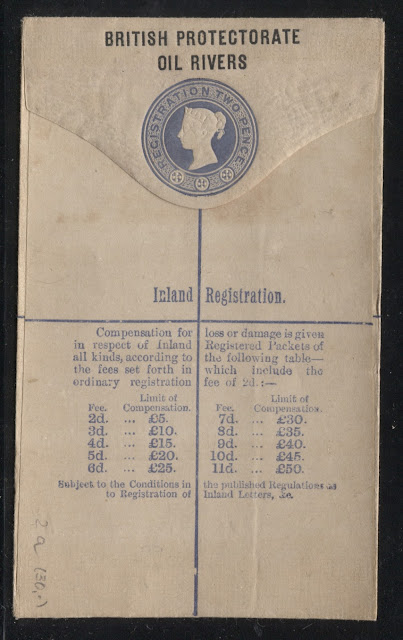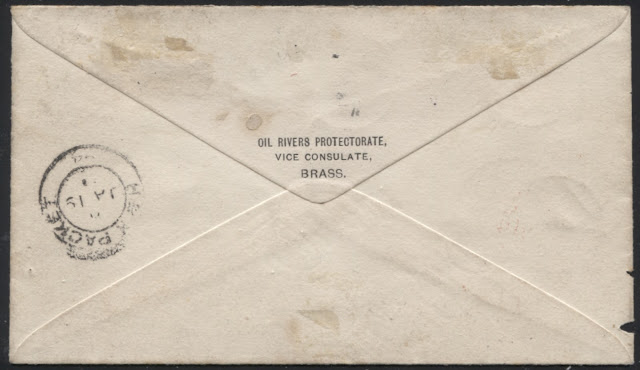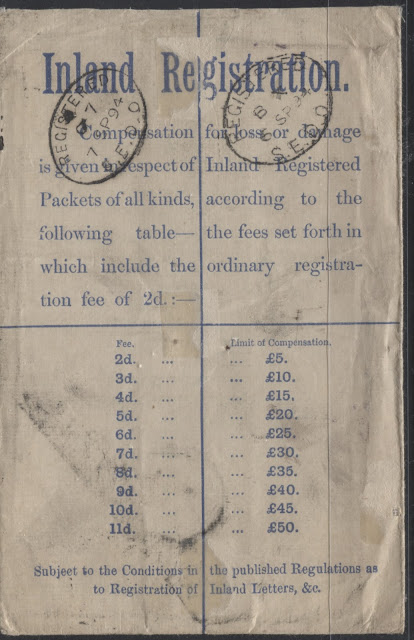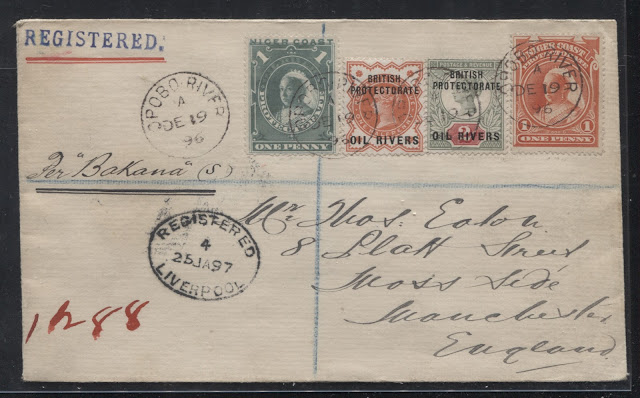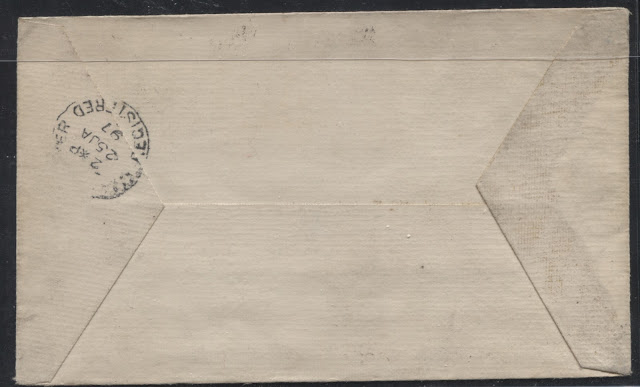This week, I will showcase a number of covers and postcards from the Niger Coast Protectorate that fall into the period covered by the overprinted Great Britain issues. Two of these covers were featured in my post last week, but I will show them again here.
Niger Company Territories
Before the formation of Northern and Southern Nigeria in 1901, the area north of the Oil Rivers Protectorate was known as the Niger Company Territories. Generally, prior to the issuance of the Oil Rivers stamps, stamps of Great Britain, or Postal Stationery items were used. The only way to identify them as Niger Company Territories is by the postmarks, which were generally violet boxed handstamps from Akassa, Burutu, Abutshi and Lokoja. Akassa and Burutu are the most common village names, but that being said, none of these are common by any means. Stamps with the postmarks are scarce enough, but covers and postcards are very scarce indeed.
Below are some stamps on piece, as well as some individual loose stamps that bear cancellations that can be identified as Niger Company Territories:
A single 1d cancelled with the same handstamp, on small piece (Gibbons Z30)
A lovely example of the 5d Jubilee definitive cancelled on piece with a full and clear strike of the Akassa handstamp with voided corners.
A very rare example of a Lagos 2.5d definitive used in Burutu, rather than a GB stamp. Neither Gibbons, nor Proud make any mention of Lagos stamps being used in the territory. This is the handstamp with Burutu in serifed capitals. The stamp has a few minor faults, but remains the only example of a non-GB stamp used in the territories.
A 5d Jubilee issue used in Burutu, on piece, bearing a nice strike of the same handstamp as was used on the 2.5d stamp above. This strike is quite crisp in that both framelines are clearly visible.
Here we have a 1d lilac used on piece with a slightly different Burutu hadstamp - this one having serifed capitals.
In addition to the stamps, I have a postcard from Niger Coast Protectorate that is used in Akassa, which is located in the northern region of what became Southern Nigeria. I also have what appears to be a mint pre-stamped envelope from the post office in Burutu. This envelope is a sealed, pristine unaddressed envelope which bears a single Great Britain 1d lilac, which has been cancelled with the purple Burutu boxed handstamp.
The postcard is shown below:
The postcard is clearly a commercial card soliciting samples of merchandise. It is typewritten, which is early for a card mailed in 1898. The card itself is a Great Britain postcard that has been overprinted 'Niger Coast Protectorate", which indicates that it was overprinted after 1894. The territories did not have their own postal stationery, so a Niger Coast Protectorate card was simply used in the territories. It was mailed from the Akassa post office on September 13, 1898, and was received by the Liverpool Packet ship on October 8, 1898. There is no other marking to indicate when it arrived at its destination.
The envelope is curious and is shown below:
The Burutu boxed handstamp bears all the characteristics of being completely genuine: it is somewhat blurred and the ink colour is consistent with the kind that you see on other specimens of this period. The size and shape of the letters are all correct. So, this rules out the possibility of a fake made by taking an old envelope and affixing a cheap 1d lilac and then applying a fake cancel. But the mystery remains as to why it would be sealed and completely unaddressed.
I believe that what likely happened is that the postal clerk at the Burutu post office made up a small supply of these envelopes for sale to customers in advance. This was likely a leftover envelope from that stock. It is sealed because the gum on the flap was affected by the humidity there. That would mean that rather than being a cover, this is actually a mint postal stationery item that bears an actual stamp, and as such should be very rare.
Early Oil Rivers (Pre-1894) Postcards
I have a group of Great Britain postcards, to which an overprint has been applied to indicate that they were to be used in the Oil Rivers. All except one of the cards are the 1887 scarlet Jubilee design, and were likely intended for foreign use. The sole 1/2d card that I have was likely intended for local use. Only one of these cards is addressed, but there are no mail markings of any kind on it, so that it is not clear whether or not it was actually sent to its destination through the postal system. Two of the cards are mint and two bear CDS cancellations for Old Calabar River and Bonny River, but are otherwise completely unaddressed. The cards are shown in the scans below:
This postcard is addressed to Bergedorf, Switzerland and bears a single name on the back. However, there are no other markings - no cancel for the protectorate to indicate that it had left, and no cancel to indicate that it arrived in Switzerland. So it may well have been addressed, but not sent.
This is a relatively fresh mint example of the 1d foreign rate postcard, bearing the Oil Rivers overprint.
Here is a card bearing a November 25, 1893 Bonny River cancellation with date code C. It is entirely unaddressed and bears no message.
Another unaddressed card bearing a cancellation - this time for Old Calabar River, dated October 8, 1893 with time code A.
It is not clear whether these two cards are philatelic or not, or whether they are actually precanceled postal cards that were prepared this way for sale to the public to save time in cancelling them later. Given the existence of the envelope from Burutu above, I suspect that they are actually precanceled items.
Note the "Fee Paid" underneath the "R" in the top left corner.
On this envelope, there is no "Fee Paid".
Registered Covers
I have four registered covers bearing stamps of this issue. One of these is a mixed franking that includes stamps of the 1894 first Waterlow issue and second Waterlow issue from 1894. The first two of these are the 2/1d cover from Brass River to Dublin, and the 1/- cover to London that were featured in last weeks's post:
This cover was sent using a new, Niger Coast Protectorate Envelope. These envelopes had the indicta and knife on the front of the envelope instead of the back, and the registered letter rate table now occupies the entire back of the envelope as shown below:
There is no question that this is a commercial usage, as one of the stamps on the cover is badly damaged and from the haphazard arrangement of the stamps. This very likely contained valuable documents.
The next cover is an 8d cover sent to the UK on October 23, 1893, using an Oil Rivers envelope:
Niger Company Territories
Before the formation of Northern and Southern Nigeria in 1901, the area north of the Oil Rivers Protectorate was known as the Niger Company Territories. Generally, prior to the issuance of the Oil Rivers stamps, stamps of Great Britain, or Postal Stationery items were used. The only way to identify them as Niger Company Territories is by the postmarks, which were generally violet boxed handstamps from Akassa, Burutu, Abutshi and Lokoja. Akassa and Burutu are the most common village names, but that being said, none of these are common by any means. Stamps with the postmarks are scarce enough, but covers and postcards are very scarce indeed.
Below are some stamps on piece, as well as some individual loose stamps that bear cancellations that can be identified as Niger Company Territories:
A single 3d purple on lemon Queen Victoria Jubilee definitive stamp, cancelled at Akassa (Gibbons Z33)
A single 1d cancelled with the same handstamp, on small piece (Gibbons Z30)
A lovely example of the 5d Jubilee definitive cancelled on piece with a full and clear strike of the Akassa handstamp with voided corners.
A very rare example of a Lagos 2.5d definitive used in Burutu, rather than a GB stamp. Neither Gibbons, nor Proud make any mention of Lagos stamps being used in the territory. This is the handstamp with Burutu in serifed capitals. The stamp has a few minor faults, but remains the only example of a non-GB stamp used in the territories.
A 5d Jubilee issue used in Burutu, on piece, bearing a nice strike of the same handstamp as was used on the 2.5d stamp above. This strike is quite crisp in that both framelines are clearly visible.
Here we have a 1d lilac used on piece with a slightly different Burutu hadstamp - this one having serifed capitals.
Here is another, less clear example of the same handstamp that was used to tie two 1d lilacs and a 1/2d vermilion to a large piece. This would likely have paid the foreign UPU letter rate to the UK.
In addition to the stamps, I have a postcard from Niger Coast Protectorate that is used in Akassa, which is located in the northern region of what became Southern Nigeria. I also have what appears to be a mint pre-stamped envelope from the post office in Burutu. This envelope is a sealed, pristine unaddressed envelope which bears a single Great Britain 1d lilac, which has been cancelled with the purple Burutu boxed handstamp.
The postcard is shown below:
The postcard is clearly a commercial card soliciting samples of merchandise. It is typewritten, which is early for a card mailed in 1898. The card itself is a Great Britain postcard that has been overprinted 'Niger Coast Protectorate", which indicates that it was overprinted after 1894. The territories did not have their own postal stationery, so a Niger Coast Protectorate card was simply used in the territories. It was mailed from the Akassa post office on September 13, 1898, and was received by the Liverpool Packet ship on October 8, 1898. There is no other marking to indicate when it arrived at its destination.
The envelope is curious and is shown below:
The Burutu boxed handstamp bears all the characteristics of being completely genuine: it is somewhat blurred and the ink colour is consistent with the kind that you see on other specimens of this period. The size and shape of the letters are all correct. So, this rules out the possibility of a fake made by taking an old envelope and affixing a cheap 1d lilac and then applying a fake cancel. But the mystery remains as to why it would be sealed and completely unaddressed.
I believe that what likely happened is that the postal clerk at the Burutu post office made up a small supply of these envelopes for sale to customers in advance. This was likely a leftover envelope from that stock. It is sealed because the gum on the flap was affected by the humidity there. That would mean that rather than being a cover, this is actually a mint postal stationery item that bears an actual stamp, and as such should be very rare.
Early Oil Rivers (Pre-1894) Postcards
I have a group of Great Britain postcards, to which an overprint has been applied to indicate that they were to be used in the Oil Rivers. All except one of the cards are the 1887 scarlet Jubilee design, and were likely intended for foreign use. The sole 1/2d card that I have was likely intended for local use. Only one of these cards is addressed, but there are no mail markings of any kind on it, so that it is not clear whether or not it was actually sent to its destination through the postal system. Two of the cards are mint and two bear CDS cancellations for Old Calabar River and Bonny River, but are otherwise completely unaddressed. The cards are shown in the scans below:
This postcard is addressed to Bergedorf, Switzerland and bears a single name on the back. However, there are no other markings - no cancel for the protectorate to indicate that it had left, and no cancel to indicate that it arrived in Switzerland. So it may well have been addressed, but not sent.
This is a relatively fresh mint example of the 1d foreign rate postcard, bearing the Oil Rivers overprint.
Here is a card bearing a November 25, 1893 Bonny River cancellation with date code C. It is entirely unaddressed and bears no message.
Another unaddressed card bearing a cancellation - this time for Old Calabar River, dated October 8, 1893 with time code A.
It is not clear whether these two cards are philatelic or not, or whether they are actually precanceled postal cards that were prepared this way for sale to the public to save time in cancelling them later. Given the existence of the envelope from Burutu above, I suspect that they are actually precanceled items.
Here is an example of a 1/2d local postcard intended for use in the protectorate only. Interestingly, the overprint used here is slightly different from that applied to the 1d cards:
- The length is different. on the above card, the words "British Protectorate" approximately 41 mm to the end of the "E". on the other 1d postcards, the words measure 36.75 mm.
- There is a period after both words.
- The lines of the overprint are closer together.
Registered Letter Envelopes
I have a series of mint registered envelopes, which appear to have been produced in 4 different sizes, and with slightly different information on the back in regards to registration fees. The first larger types are 96 mm wide and between 147 mm and 150 mm long. The front and back of each type both appear the same and are shown below:
This is a standard Great Britain envelope which has been overprinted for use in the Oil Rivers. You can tell by the lack of a country name in the stamp indicta on the back knife. These envelopes show the registration fees up to 11d for 50 pounds of coverage.
The smaller envelopes are 78-79 mm wide and 128-131 mm long. There are two types that differ in terms of what appears on each side of the envelope:
- The front shows the words "Fee Paid" with a period after "paid" and an underline. The back shows the stamp indicta for the basic 2d registration fee, the overprint and a double sided table showing the registration fees and coverage amounts from 2d and £5 to 11d and £50.
- The front does not show the words "Fee Paid" at all. The registration fee and compensation amounts are only shown from 2d and £5 to 6d and £25.
The scans below show some of these differences:
Note the "Fee Paid" underneath the "R" in the top left corner.
Here, you can see two tables of compensation rates and registration fees.
On this envelope, there is no "Fee Paid".
Here, there is a smaller table of rates that now only goes as high as 6d and £25.
An example of the same envelope with "Specimen" overprint.
Registered Covers
I have four registered covers bearing stamps of this issue. One of these is a mixed franking that includes stamps of the 1894 first Waterlow issue and second Waterlow issue from 1894. The first two of these are the 2/1d cover from Brass River to Dublin, and the 1/- cover to London that were featured in last weeks's post:
This cover may be philatelic, but on the other hand, the 1d stamp has a missing corner, which would very likely not have been the case on a philatelic cover. The back of the envelope shows that it was sent from the Vice Consulate in Brass, which does suggest that it may well have been commercial in nature. Interestingly, there are no registration markings on the envelope.
This cover was sent using a new, Niger Coast Protectorate Envelope. These envelopes had the indicta and knife on the front of the envelope instead of the back, and the registered letter rate table now occupies the entire back of the envelope as shown below:
There is no question that this is a commercial usage, as one of the stamps on the cover is badly damaged and from the haphazard arrangement of the stamps. This very likely contained valuable documents.
The next cover is an 8d cover sent to the UK on October 23, 1893, using an Oil Rivers envelope:
The UK letter rate was 2.5d, so 5.5d of registration fee has been paid. The closest increment is 5d of registration fee to insure £20. So this likely contained £20 of value and has been overpaid by 1/2d, because there were no 1/2d stamps available at the time of mailing.
The next cover is the mixed franking cover from 1896. It is a very late usage of this issue and technically, really should be included in the period of the next issues as well:
This commercial cover was sent from Opobo River to Manchester on December 19, 1896. The postage of 4.5d indicates that 2d was paid to provide indemnity to the tune of £5. The postage was paid with a 2d and 1/2d of this issue as well as 1d values from each of the next two issues. The backstamp is unclear, but the letters that are readable suggest that it is Manchester. It indicates that the cover arrived on January 25, 1897.
This concludes my exploration of the postal history of the 1892-1894 period of Niger Coast Protectorate and the Niger Company Territories. Next week I will look at the provisional surcharges as well as some larger mint multiples. Then I will have completed this issue and can start looking at the first Waterlow issue of 1894.


